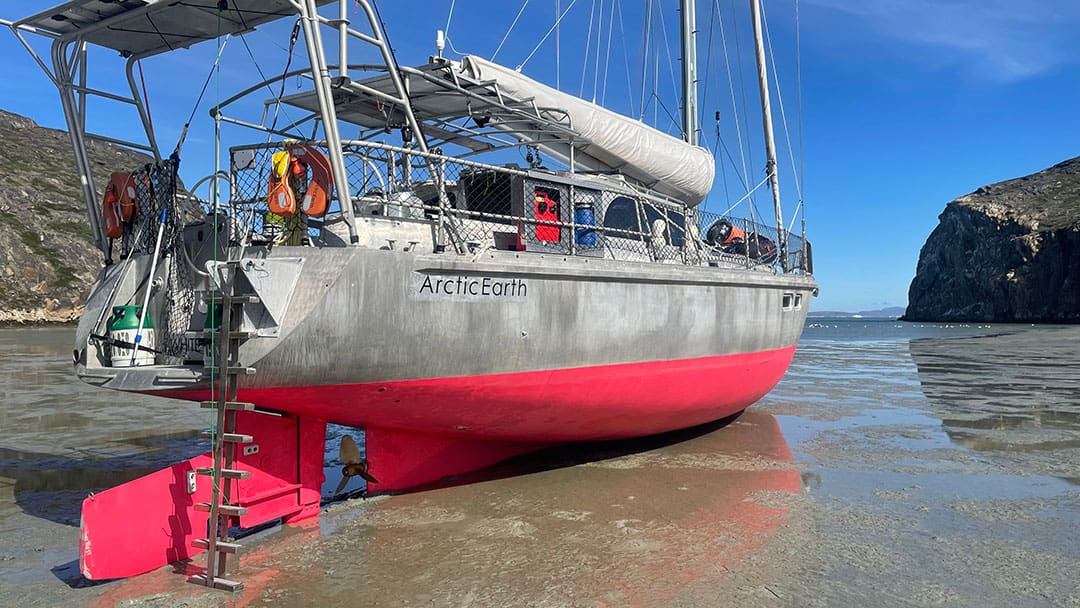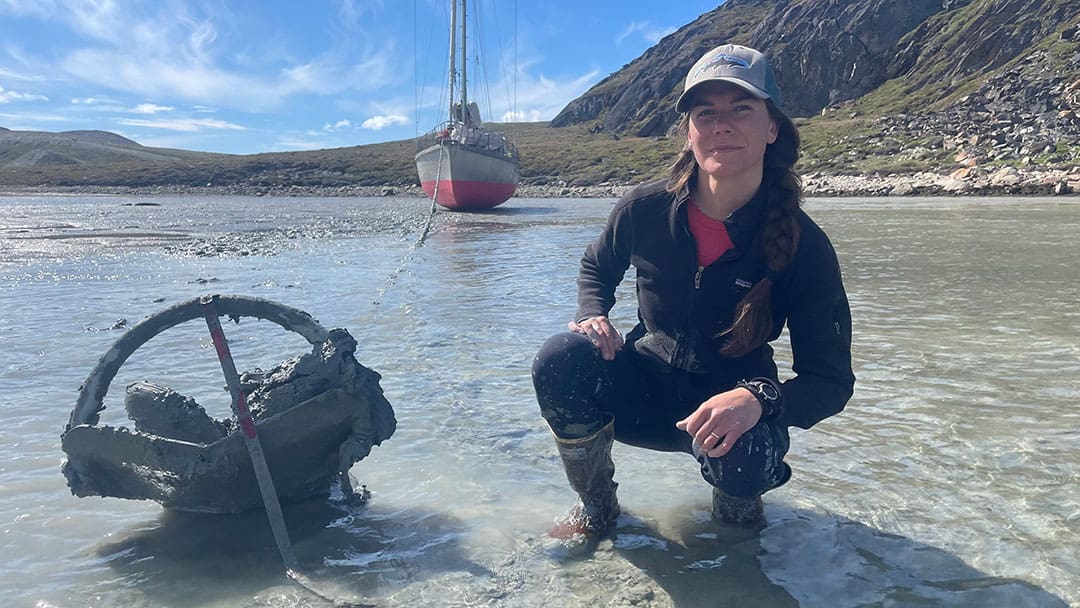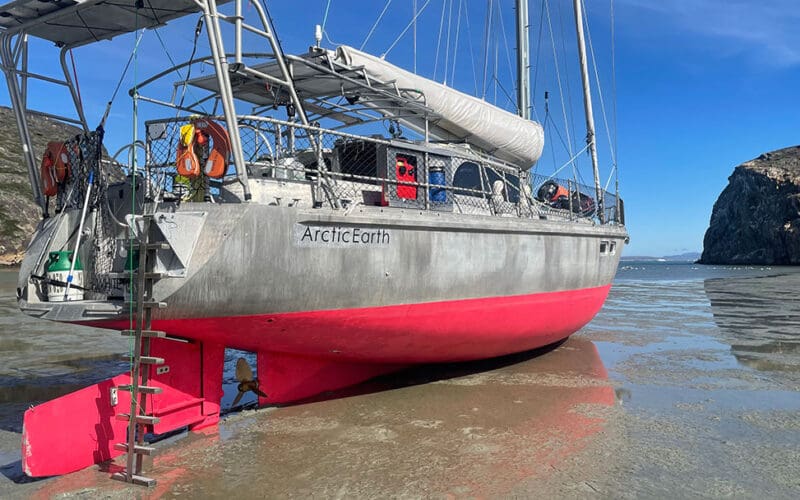
Summertime, north of the Arctic Circle, and the expedition vessel ArcticEarth is sailing in coastal waters where the charts do not show depths. With vigilance, Captain Magnus Day and Mate Julia Prinselaar are moving the boat northward. Their goal is to be fully ready, provisioned, and in position next week for two upcoming charters in Disko Bay, on the west coast of Greenland. Disko has the reputation of an exciting place with lots of ice (one glacier dumps 35 billion tons of ice into the sea each year at a flow rate that can exceed 150 feet per day… that’s Sermeq Kujalleq, the fastest-moving tidewater glacier on the planet). But ice is not the only excitement in the neighborhood. There’s also mud.
ArcticEarth is stocked with food and gear, designed and built for “any ocean on earth,” per the relatively rare and most stringent category zero certification it maintains via inspections from the British-based international marine consultants and certifying authority MECAL. Not many sailing vessels are in this certification class, and the ability to use the wind is not its only nod to self-reliance. The crew is experienced and resourceful, and the boat has a special capability that is about to be put to use.
 “After seeing a few muskox up on the ridge,” Magnus said, “we move down the shore and start looking for a place to anchor for the night and go into an almost flat bottomed cove with acres of soft gooey mud with firm mud below. We realize this is the perfect location to dry out, something we wanted to practice.” Drying out, or mud-berthing, is commonly done in certain parts of the world, where the tidal range and cycle allows. Historically, wooden vessels in need of remote repair would seek out careening beaches where they could lie on their sides. But drying out is not a common practice these days for a modern deep-keeled ocean voyager, like ArcticEarth, that draws nine feet.
“After seeing a few muskox up on the ridge,” Magnus said, “we move down the shore and start looking for a place to anchor for the night and go into an almost flat bottomed cove with acres of soft gooey mud with firm mud below. We realize this is the perfect location to dry out, something we wanted to practice.” Drying out, or mud-berthing, is commonly done in certain parts of the world, where the tidal range and cycle allows. Historically, wooden vessels in need of remote repair would seek out careening beaches where they could lie on their sides. But drying out is not a common practice these days for a modern deep-keeled ocean voyager, like ArcticEarth, that draws nine feet.
This boat, however, has a swing ballast keel and rudder. When both keel and rudder are winched into the up positions, the boat draws only three feet, as designed by Ed Joy of Camden, Maine. Ed also drew up a canoe-shaped aluminum hull so that ArcticEarth could rest evenly and upright. That is exactly what happens here in Greenland. As the tide drops, the hull settles in. Julia lowers the hinging dive ladder and “Bob’s your Uncle!”
Magnus had dried out swing-keeled expedition vessels in other parts of the world, but this is the first time for both him and Julia in Greenland on ArcticEarth. Magnus descends and walks around the hull to check the rudder, the anodes, and the cutlass bearings. All look pretty good, though he notes that the bearing has a little play and will need replacement soon. Next, he inspects the propeller. ArcticEarth has already seen plenty of ice this summer in southwest Greenland, and the propeller is vulnerable when turning or moving astern through loose bergy ice. But the prop, too, looks fine. Comforting to know that a spare is on board and that swapping out a disabled propeller does not require reaching a boatyard that could be many days distant!
There are other advantages to a swing keel in the waters of Greenland. In reasonable conditions, the keel may prove to be a great depth sounder. When you run aground in the poorly sounded waters, you simply winch up the keel and set off again in a different direction. The capability to swing also offers protection from drifting ice. Winch it up and anchor in shallow water, beyond the reach of deep draft icebergs. The swing keel concept has been around for more than 50 years, since Michel Joubert designed a vessel named Damien II for Jérôme and Sally Poncet. There are some disadvantages: extra construction cost, maintenance time/cost and a loss of interior space that is occupied by the keel well.
On this day, the tide is starting to turn. Shore is not too far away. Julia volunteers to climb down to the mud and walk forward under the bow anchor, while Magnus lowers the 121-pound Rocna and pays out half-inch chain from the deck above. “Would this even be possible,” Julia recalls thinking to herself as she descends the ladder, “what if I end up sinking into the mud?” She does sink a few inches, but then finds firmament. “The Canadian in me then mud-skates to catch the anchor. And then there was the long and muddy drag!” Meanwhile, Magnus is up on the foredeck, musing on the right length of anchor chain if anchoring in zero feet of water. “Keep going!” as he looks up and over the rail. “Watching Julia haul the anchor and the chain through the slimy slippery mud was great fun — from the foredeck. So much so that I had to make a video!”
Julia relished the adventure. “My boots, pants and shirt were covered in mud that dried into an impossible-to-wash crust that took two days to remove. But it was so much fun — a day I’ll never forget.”
Underway and heading for the next charter, Magnus is pleased with the practice session. “Having sailed almost every swing keel design out there,” he reflects, “I can say with certainty that Ed Joy’s design is the best by far and really the only one that is not inconvenient or even awkward to operate.”
David Conover is a filmmaker and sailor who developed the ArcticEarth initiative. ArcticEarth offers international charters in the northwest Atlantic and Conover intends to return to Greenland every year until 2026. For information on 2023 expedition charters, see www.arcticearth-charter.com/expeditions/.

